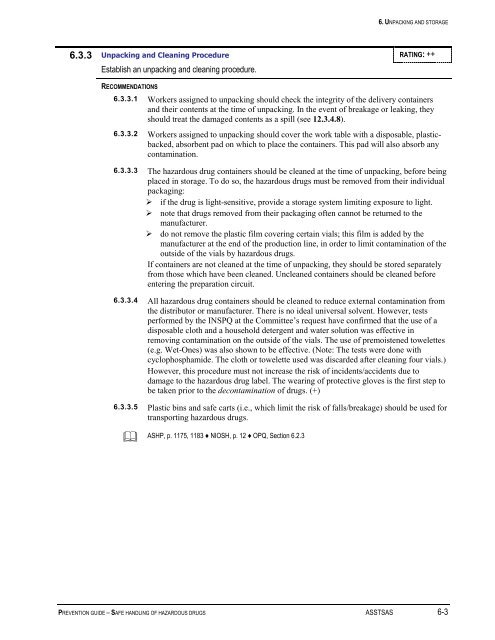Prevention Guide - Safe Handling of Hazardous Drugs - Irsst
Prevention Guide - Safe Handling of Hazardous Drugs - Irsst
Prevention Guide - Safe Handling of Hazardous Drugs - Irsst
You also want an ePaper? Increase the reach of your titles
YUMPU automatically turns print PDFs into web optimized ePapers that Google loves.
6. UNPACKING AND STORAGE<br />
6.3.3 Unpacking and Cleaning Procedure RATING: ++<br />
Establish an unpacking and cleaning procedure.<br />
RECOMMENDATIONS<br />
6.3.3.1 Workers assigned to unpacking should check the integrity <strong>of</strong> the delivery containers<br />
and their contents at the time <strong>of</strong> unpacking. In the event <strong>of</strong> breakage or leaking, they<br />
should treat the damaged contents as a spill (see 12.3.4.8).<br />
6.3.3.2 Workers assigned to unpacking should cover the work table with a disposable, plasticbacked,<br />
absorbent pad on which to place the containers. This pad will also absorb any<br />
contamination.<br />
6.3.3.3 The hazardous drug containers should be cleaned at the time <strong>of</strong> unpacking, before being<br />
placed in storage. To do so, the hazardous drugs must be removed from their individual<br />
packaging:<br />
‣ if the drug is light-sensitive, provide a storage system limiting exposure to light.<br />
‣ note that drugs removed from their packaging <strong>of</strong>ten cannot be returned to the<br />
manufacturer.<br />
‣ do not remove the plastic film covering certain vials; this film is added by the<br />
manufacturer at the end <strong>of</strong> the production line, in order to limit contamination <strong>of</strong> the<br />
outside <strong>of</strong> the vials by hazardous drugs.<br />
If containers are not cleaned at the time <strong>of</strong> unpacking, they should be stored separately<br />
from those which have been cleaned. Uncleaned containers should be cleaned before<br />
entering the preparation circuit.<br />
6.3.3.4 All hazardous drug containers should be cleaned to reduce external contamination from<br />
the distributor or manufacturer. There is no ideal universal solvent. However, tests<br />
performed by the INSPQ at the Committee’s request have confirmed that the use <strong>of</strong> a<br />
disposable cloth and a household detergent and water solution was effective in<br />
removing contamination on the outside <strong>of</strong> the vials. The use <strong>of</strong> premoistened towelettes<br />
(e.g. Wet-Ones) was also shown to be effective. (Note: The tests were done with<br />
cyclophosphamide. The cloth or towelette used was discarded after cleaning four vials.)<br />
However, this procedure must not increase the risk <strong>of</strong> incidents/accidents due to<br />
damage to the hazardous drug label. The wearing <strong>of</strong> protective gloves is the first step to<br />
be taken prior to the decontamination <strong>of</strong> drugs. (+)<br />
6.3.3.5 Plastic bins and safe carts (i.e., which limit the risk <strong>of</strong> falls/breakage) should be used for<br />
transporting hazardous drugs.<br />
<br />
ASHP, p. 1175, 1183 ♦ NIOSH, p. 12 ♦ OPQ, Section 6.2.3<br />
PREVENTION GUIDE – SAFE HANDLING OF HAZARDOUS DRUGS ASSTSAS 6-3

















